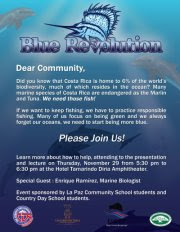For the second trimester of my LEEP, I will be doing an internship with the Leatherback Trust located in Playa Grande (20 minutes from my school). My mentor is named Tera Dornfeld,who is originally from Wisconcin and has been working as a Leatherback Trust field biologist for the past 6 years. Here is a map of the location of the Leatheack Trust.
Here is information about the Leatherback Trust....
The Leatherback Trust is a non-profit foundation established by James R. Spotila, Ph.D. to save the leatherback turtle and other sea turtles from extinction. The Leatherback Trust scientists were instrumental in founding a new national park, Parque Marino Las Baulas, on the Pacific coast of Costa Rica. The park protects the most important leatherback nesting beaches in the Pacific Ocean. Our scientists have trained park rangers and guides, worked with local school children and advised the local community on living in harmony with the leatherbacks. Before the Park was established poachers took 100% of nests. Now almost all nests are protected and a hatchery protects nests that would be washed away by high tides or eaten by predators. Now thousands of hatchlings crawl to the ocean every season where five years ago only a few survived.
On Wednesday, January 23rd, I met Tera for the first time. She is the person I will be working with this trimester. We went out to a nest site and as we began to excavate it, we discovered that it was actually two different nest
sights that were layered upon each other. First we tried to located the older eggs, but only found the newer, unhatched eggs. So they had to stop in fear of disrupting the
undeveloped eggs. We then moved on to an Olive Ridley turtle nest where we found one baby
turtle that was unable to make it’s way out of the nest and out to the sea. We put the hatchling into a bucket with a little sand and water so that it can be released later. The plan is to release them at
night not only because they could die from the heat of the day, but also because of predators that might
want to eat them as they walk slowly to the water. It is also safer for them to go at night time when they
are less visible.
Here are some pictures from the dig
sites and a couple of videos of the turtle moving around in the bucket that I
carried back in to the center. The best part was showing the baby turtle to people on the beach and explaining to them about turtles and turtle conservation.


.JPG)
.JPG)
.JPG)
.JPG)
.JPG)
.JPG)
.JPG)
.JPG)
.JPG)
.JPG)
.JPG)
.JPG)
.JPG)
.JPG)
.JPG)
.JPG)
.JPG)

















